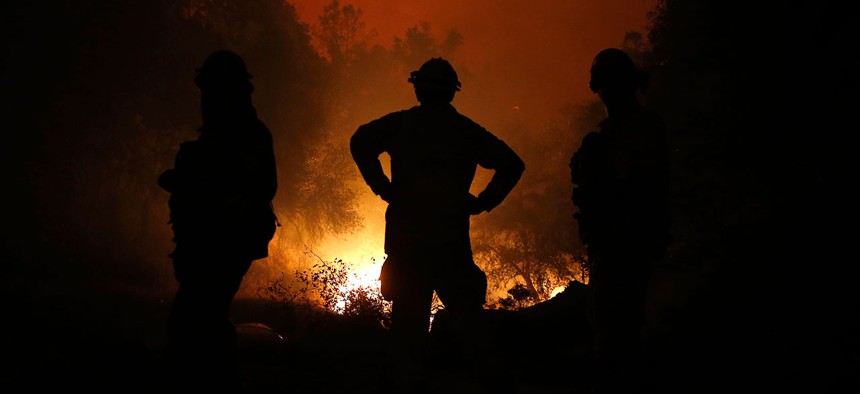
Firefighters watch as the flames of the Butte Fire approach a containment line near San Andreas, Calif., Sept. 11, 2015. Rich Pedroncelli/AP
National Interagency Fire Center: The 2015 Fire Season is Among the Worst in Recent Memory
Drought and climate change have combined to produce the largest area burned in more than a decade.
Compassion fatigue and disaster fatigue are just as potent in the U.S. as they are with the refugee crisis in Europe. Each summer, it seems like the news fills up with headlines about enormous wildfires across the West, tearjerking anecdotes of residents who have lost their homes, and spectacular photos of firefighters and flames. Each year, the stories include new “worsts” and historical records. At some point, especially for those far away from the fires, it becomes hard to tell just how bad a given fire season is. So how does 2015 stack up? Does it just feel worse because it’s happening right now?
The truth is this year is among the worst in recent memory, according to statistics kept by the National Interagency Fire Center . Helpfully, the center tracks fires up to this point in the year going back a decade, so it’s easy to make an apples-to-apples comparison.
The number of fires is actually down in recent years—but look at the number of acres burned and the picture changes. More land has burned so far in 2015 than in the same period in any year in the past decade.
The staggering 8.8 million acres burned represents a serious reversal from earlier in the season. When Climate Desk checked in on fires in April , they found that 2015 had one of the lowest totals in a decade, lagging far behind 2006. Since then, massive fires, particularly in California, have closed the gap and then some.
That’s not unexpected. Even in the spring, officials were predicting an awful year for fires. California, which has received the most attention, is in a long and painful drought that has led the state government to take unprecedented water-conservation measures. But Washington and Oregon are also in the midst of droughts, and active fires have burned nearly three times as many acres in Washington as they have in California.
Droughts can be cyclical, and aren’t necessarily tied to climate change. But scientists note that the warming trend means that forests have lost moisture, so they’re more susceptible to fires when they come . Higher temperatures have also led to dwindling snowpack , so that dry conditions reach into increasingly higher altitudes. My colleague Alana Semuels recently reported from Alaska , where the state has been hit with record fires, even as it had to reroute the famous Iditarod race for lack of snow.
Meanwhile, there are increasingly urgent questions about the way the U.S. approaches fire management. Fighting fires can break natural cycles of burn and recovery, but as people move into potential burn areas, it’s harder for firefighters to make the case for standing back and letting the flames go. One result of this strategy is hotter and larger fires. Fire managers refer to anything larger than 100,000 acres as a “megafire,” and before 1995, there was an average of less than one per year . But that number has begun steadily climbing . At this moment, there are five active megafires.
In other words: Yes, those headlines every year about the growing danger from fires aren’t just fearmongering or a failure to contextualize numbers with recent history. The danger from wildfires really is larger now than it used to be. If there’s any good news, it’s that NIFC expects fire potential from central California north to decrease in October—but Southern California still faces an elevated risk of burning. It could be a hot and painful fall.






